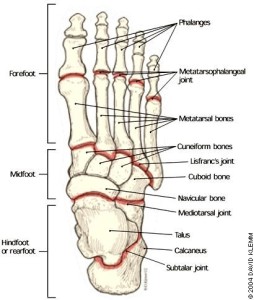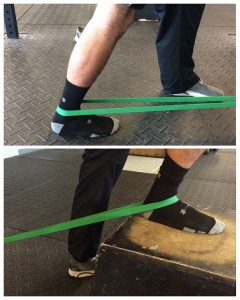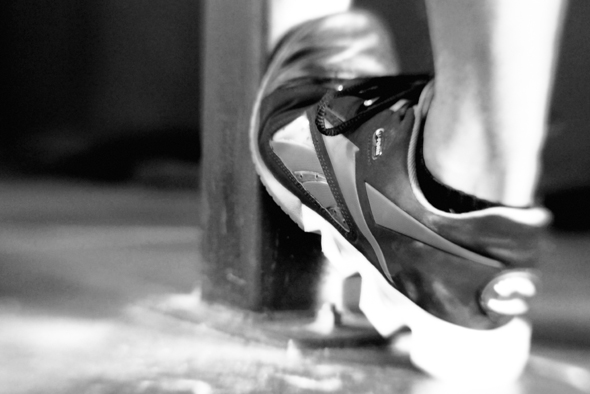Stiff Feet and Tight Ankles: Why Stretching Isn’t the Answer

Neurokinetic Therapy; “The Missing Link” in Treating Your Pain and Injuries
November 23, 2015
Are Your Shoulders Giving You Neck Pain and Headaches?
December 17, 2015When patients come in complaining of back, shoulder, or even neck pain, they will commonly ask me why I’m evaluating their feet and ankles. My response usually goes something like, “you can’t build a pyramid without a base.” Simply put, your feet are the bridge between the ground and the rest of your body as you stand and move around all day, so it’s critical that they are in the right condition to handle that stress properly. Combined with your ankles, they absorb and transfer the forces associated with impacting the ground, and are vital for setting up the proper kinetic chain of command involving muscles and joints moving up the body. This includes knee, hip, core, and shoulder function. For the sake of this post though, I’m going to focus just on the ankles and feet, but will list some mechanical problems that may arise elsewhere at the end.
 Since the feet endure and transfer high impact forces, they are designed to be rigid and stable, particularly near the heel and mid-foot. The bones are tightly packed and naturally don’t have a lot of movement. This makes certain areas of the foot susceptible to becoming overly stiff, leading to painful stress points and altered mechanics. Stress fractures are a good example of this.
Since the feet endure and transfer high impact forces, they are designed to be rigid and stable, particularly near the heel and mid-foot. The bones are tightly packed and naturally don’t have a lot of movement. This makes certain areas of the foot susceptible to becoming overly stiff, leading to painful stress points and altered mechanics. Stress fractures are a good example of this.
Your ankles on the other hand should be able to move through a much larger range of motion. As this naturally creates a more unstable joint, the ankles are much more prone to being injured by excessive motion (like with ankle sprains). The catch is, if you don’t routinely move the ankle through its full range of motion, the tissues that surround the joint will become tight and restricting. An easy way to test if you have restricted ankle mobility is to place your toes about 5 inches from a wall in a kneeling position and see if you can reach the wall with your knee without raising your heel.
The most common deficiency find during evaluations is the inability to properly dorsiflex the ankle. Movement here is important when moving through your gait cycle or squatting to pick up a heavy object. There are often other associated findings, but people generally can’t move their  shin over their toes very effectively. This is usually to no surprise of the patient when I mention it. They know they have tight ankles, they’ve tried to stretch or roll their calves, but the tightness never seems to improve long term. That’s because the true issue often isn’t in their calves. Although the calves may be tight, they are usually reacting to an overly tight joint capsules (ligaments surrounding the joint). Tightness in the back of the joint not only restricts movement at the back, but also shift the talus forward which inhibits the tibia from hinging over the foot. The ankle joint itself can’t properly bend, so the muscles that move it react by tightening.
shin over their toes very effectively. This is usually to no surprise of the patient when I mention it. They know they have tight ankles, they’ve tried to stretch or roll their calves, but the tightness never seems to improve long term. That’s because the true issue often isn’t in their calves. Although the calves may be tight, they are usually reacting to an overly tight joint capsules (ligaments surrounding the joint). Tightness in the back of the joint not only restricts movement at the back, but also shift the talus forward which inhibits the tibia from hinging over the foot. The ankle joint itself can’t properly bend, so the muscles that move it react by tightening.
They also typically have a stiff mid-foot that has a reduced arch. When the ankle doesn’t properly bend, the foot defaults to this position to allow the ankle to bend and move shin over the foot. Stretching the calves won’t correct either of these issues. Rather, releasing the restrictive capsule will create more room for the ankle to move and allow the calves to relax. Mobilizing and strengthening the mid-foot at the same time will allow for better alignment and arch support throughout movement.
Distance runners, swimmers, and “desk jockeys” often present with this particular set of findings, as their ankle movements during sport or work tend to be very limited. Fortunately, the problem can be addressed easily and effectively.
 A great way to improve your ankle mobility at ankle is to use a Theraband or mobility bands to assist dorsiflexion. Since tightness is usually at the posterior aspect of the joint and limits the forward hinge, you want to assist the shin forward as you bend the ankle forward. There are two ways to do this, both pictured below. The top picture shows the band around the back of the shin, parallel to the ground, and at the level of the Achilles tendon. The bottom picture has the band around the front/top of the foot, just below the ankle joint, with resistance pull down and back.
A great way to improve your ankle mobility at ankle is to use a Theraband or mobility bands to assist dorsiflexion. Since tightness is usually at the posterior aspect of the joint and limits the forward hinge, you want to assist the shin forward as you bend the ankle forward. There are two ways to do this, both pictured below. The top picture shows the band around the back of the shin, parallel to the ground, and at the level of the Achilles tendon. The bottom picture has the band around the front/top of the foot, just below the ankle joint, with resistance pull down and back.
- Place the band at the proper position
- Keep your feet straight and firmly planted
- Work the knee as far over the middle toe as possible without lifting the heel
- Repeat 12-15 times for 1 set
- Perform 2 sets, 2x/day (especially before athletic activity)
Mobilizing the midfoot can be tough to do by yourself however. I recommend seeing a functional chiropractor to have it evaluated and treated with manipulation and soft tissue treatments. We specialize in correcting these kind of issues quickly so you can get back to moving pain free in a short period of time. If you have any of the issues listed below, or would like a comprehensively evaluation to help prevent any from developing, call use at 724-220-4246, or email at [email protected]!
What are some common issues associated with tight feet and ankles?
- Knee pain resulting from increased knee valgosity (crashing inward)
- Posterior chain weaknesses (calves/hamstrings/glutes)
- Achilles tendonitis
- Runners knee
- Ankle impingement (pinching)
- Stress fractures of the heel or midfoot
- Chronic calf tightness
- Ankle sprains
- Plantar fasciitis
- Shin splints
- IT-Band tightness
![Jaicks_logo_final[1]RGB208](https://jaicksspinesport.com/wp-content/uploads/2015/08/Jaicks_logo_final1RGB208.png)
